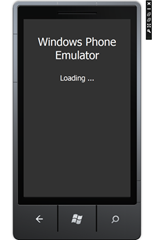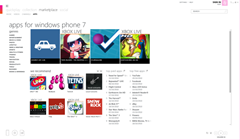Windows Phone 7 Apps - Getting from Concept to Customer
This week’s MSDN Flash guest author is….. well, me. Now Windows Phone 7 has launched in all markets and you can wander down to your local high-street retailer and take your pick of whichever device most takes your fancy (see below)….
I thought it was a good time to look at WP7 applications and specifically how to get your ideas for applications off the ground. So, without further ado, over to me…
With Windows Phone 7, as well as an amazing user experience from the OS, you'll also find an amazing selection of apps waiting for you in the Marketplace. Thousands of developers from around the world have recognised the opportunity and opted to build or port their app to Windows Phone. If you're interested in doing the same, I’d like to offer you a few tips to make the journey from concept to customers as smooth as possible.
![Image courtesy of https://flickr.com/purecaffeine/ UI Mock Up]() 0. Decide on your app
0. Decide on your app
From travel apps to games, business productivity to children's entertainment, there's all the scope you need. Just come up with a great idea you think you can put into practice.
1. Pick your poison
Silverlight or XNA? Those are your choices. Pick the most appropriate (Silverlight offers a control-based model for RAD development of rich applications, XNA is targeted more at action games – with a game loop - and apps that have the most demanding graphics requirements). Click here for more details.
2. Understand the framework on the phone
Read through the MSDN documentation and download Charles’s Petzold’s free ebook.
 3.Build and test
3.Build and test
Download the Windows Phone Developer Tools (and note, there is an update available) and get started. The download contains all you need to get going including versions of Visual Studio and Expression Blend for Windows Phone, the Windows Phone emulator and the Silverlight and XNA frameworks. Start the process of building and testing your app using the emulator.
4. Register for App Hub
 App Hub is *the* place for developing for Windows Phone (and Xbox 360). Register to developer unlock your Windows Phone (allowing you to deploy and debug direct from Visual Studio). You will also need to be registered to publish your finished application to the Marketplace. Registration costs £65+VAT per year. You can submit as many paid apps as you like and make up to 5 free app submissions (you can submit more but there’s a fee).
App Hub is *the* place for developing for Windows Phone (and Xbox 360). Register to developer unlock your Windows Phone (allowing you to deploy and debug direct from Visual Studio). You will also need to be registered to publish your finished application to the Marketplace. Registration costs £65+VAT per year. You can submit as many paid apps as you like and make up to 5 free app submissions (you can submit more but there’s a fee).
Click here for a walk-through of the registration process. Note that the registration process can take some time to complete (eg it includes identity verification checks). You may want to start the process sooner rather than later.
5. Make sure your application complies with the policies
There’s a well documented set of policies your application must comply with to be published in the Marketplace. If your application fails submission because it doesn't comply with the policies, it will be rejected. This adds delay, and in the case of free apps, it also counts as a submission so it’s imperative that you test and ensure you comply. For some common pitfalls you’ll want to avoid, check out “How (Not) to Fail Marketplace Ingestion”
![Image courtesy of https://www.flickr.com/thomaspurves/ Obfuscated watch]() 6. Obfuscate and instrument
6. Obfuscate and instrument
If you want to protect your code from prying eyes you’ll need to consider obfuscating it. Fortunately we’ve secured a deal with PreEmptive solutions whereby you can get access to their Dotfuscator for Windows Phone product for free until March next year. As a bonus, that also gives you access to instrumentation capabilities so you can find out which bits of your app are being exercised the most, what performance is like, how often it’s being used etc.
7. It’s not about the money
Will your app be free or will you be charging for it? Will you be monetizing it in some other way (eg through advertising). If you’re charging for your app you’ll need to think about your price point (you can charge anywhere from $0.99 to $499.99 for a paid app - or the equivalent price points in other currencies). It’s worth having a browse around the Marketplace to see if there are similar apps available, how they compare and how much they cost.
If your app is free, remember you’re restricted to 5 free app submissions (see point 4 above)
 8. Submit your application to the Marketplace
8. Submit your application to the Marketplace
When you’re ready, you can submit your app to the Marketplace. Your application and all its metadata, icons, screenshots etc will be uploaded. The package will be checked by Microsoft for compliance with the application certification requirements (see point 5) to ensure it functions as expected. This process usually takes a few days.
Assuming your application passes, the package will then be signed and published on the Marketplace where people can download and install it on their device. Click here for a walk-through of the application submission process.
9. Sit back, relax and let the £££ (or kudos) roll in
Best of luck!
About the author
 As an evangelist here at Microsoft I’m all about enabling talented developers to build great applications on Microsoft Windows Phone 7. I’m also the technical editor of the UK MSDN Flash newsletter, the fortnightly round up of Microsoft developer news and events.
As an evangelist here at Microsoft I’m all about enabling talented developers to build great applications on Microsoft Windows Phone 7. I’m also the technical editor of the UK MSDN Flash newsletter, the fortnightly round up of Microsoft developer news and events.
You can follow me on Twitter @MikeOrmond
You’ll find me blogging at https://bit.ly/mikeormond
Image Credits
https://flickr.com/purecaffeine/
https://flickr.com/thomaspurves/
